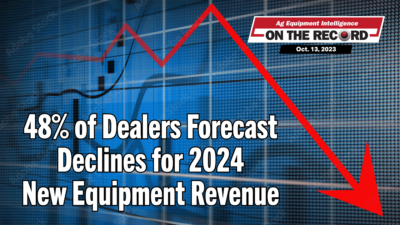The term “artificial intelligence” has generated pages of dystopian copy surrounding the displacement of jobs and the dehumanization of the workplace, but on the ground, in farm fields, AI or “machine learning” is proving to be an efficient ally of growers combatting weeds and keeping expenses in check.
In the 1980s researchers were elated when they developed sprayers capable of on-the-go determination between bare ground and growing plants — a breakthrough that paved the way for what is now widely-known as GreenSeeker technology. From crude sensors that differentiated the color of soil vs. the color of green plant material the effort led to precision spectral radiance technology that provides today’s backbone of remote sensing used in precise fertilizer placement.
As digital memory became increasingly miniaturized, it was possible to photograph and catalog various weeds in computer files used by applicators to further differentiate weeds from growing crops as they travel across fields — the entry of AI into agriculture, a debut that will forever change farm practices.
John Deere’s first See & Spray system introduced in 2021 allowed growers to reduce their non-residual pre-emergence herbicide use by more than 75% by targeting and spraying only weeds on fallow ground. That system installed on Series 400 and 600 sprayer allowed a single machine to act as an effective spot-sprayer as well as a broadcast applicator.
In 2022 Big Green launched See & Spray Ultimate for in-season targeted sprays for weeds in corn, soybeans and cotton. The system also features the ability to use two independent tank mixes in one pass, and conservatively saves growers more than two-thirds the spray volume needed for in-season weed control. The “brains” of the system was developed by Deere’s wholly owned subsidiary Blue River Technology which tapped the capability of computer vision and AI to detect weeds from crop plants with cameras mounted every meter across the width of the spray boom. Deere says strip trials in Illinois soybeans showed the system provided a 7% improvement in weed control over a broadcast single tank mix application.
Simultaneously, research reported in August from Israel’s Greeneye Technology showed the company’s proprietary AI system could save growers more than $60/acre in herbicide cost over traditional post-emergence broadcast applications.
The tests by the University of Nebraska-Lincoln marked the first commercial season in the U.S. and showed an 87% reduction in post-emergence herbicide use with the same or similar levels of efficacy compared with broadcast spraying. In burndown trials the system provided a 94% reduction in chemical use.
Economic benefits estimated in the trials showed total (residual and non-residual) herbicide costs of $40.60 per acre with Greeneye vs. $105.80/acre with broadcast treatment.
Greeneye CEO Nadav Bocher says his company’s system — a combination of proprietary AI and sprayer hardware — differentiates between crops and weeds in real time to apply crop protectants directly onto weeds.
“While reducing chemical use and cutting costs is hugely compelling, to provide a truly viable solution for farmers, precision spraying must also be able to achieve weed control on a par with broadcast applications,” he explains. “The UNL trial proves we can provide the ultimate combination of savings and efficacy in the field.”
Bocher says Greeneye is targeting the aftermarket with a system designed to seamlessly adapt to any brand or size commercial sprayer as a retrofit. He says the system will be made available in a large, selected area of the U.S. in 2023.
Similar on-farm machine learning success stories are emerging from the irrigation world as growers use AI-linked digital cameras mounted on sprinkler spans with applications such as Valley’s Insight program. There, span-mounted cameras monitor crops for damage from insects and disease, and for overall plant-health — adding more precision to regular scouting programs.
Reports from growers in high-value crops in the Pacific Northwest (where the system was initially introduced) indicate early-detection of insect hot spots helps them control outbreaks before they affect entire fields. Also, they say digital images of growing crop canopies help them better manage fertility and water management throughout the year.
In other irrigation-related applications, sprinkler-mounted sensors and AI databases monitor machine performance and position to provide irrigators with real-time notice of problems with sprinklers, span alignment and tower powertrain malfunctions.
On-board AI equipment is also helping make real-time automatic adjustments to harvesters as they move through varying field and crop conditions, relieving the operator from continuous machine adjustment.
Look for increasing use of database “knowledge” in nearly every aspect of farm equipment with every new model year. Like it or not, on-board digital intelligence is already in the jump seat, make good use of it.







Post a comment
Report Abusive Comment